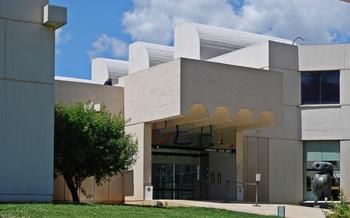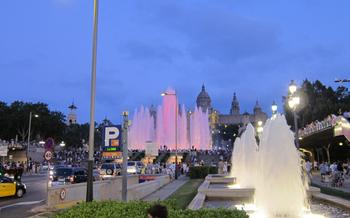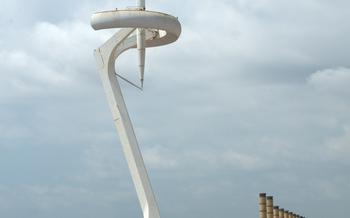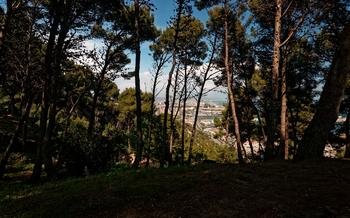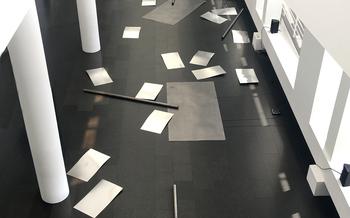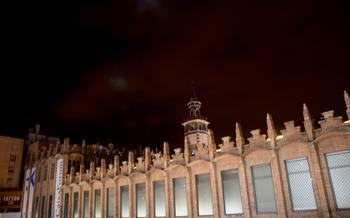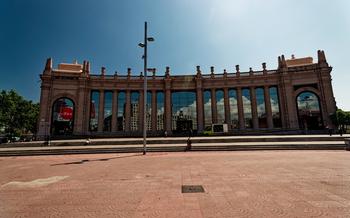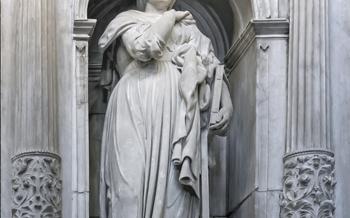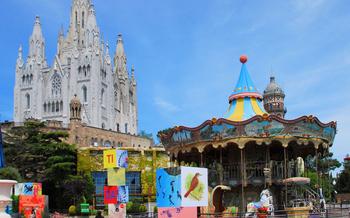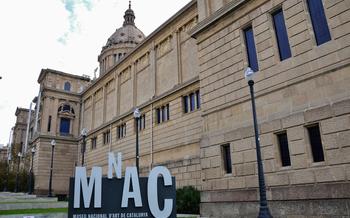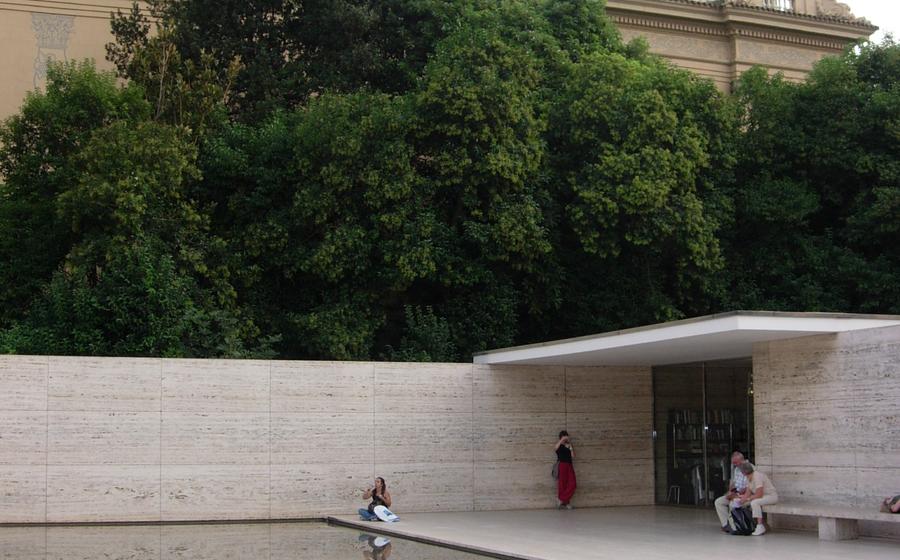
Barcelona Pavilion
- Barcelona Pavilion: A Masterpiece of Modernist Architecture
- Location and Accessibility
- Visiting Hours and Admission Fees
- Architectural Highlights
- Furniture and Interior Design
- Historical Significance
- Temporary Exhibitions and Events
- Surrounding Gardens
- Views from the Pavilion
- Photography Tips
- Accessibility for Visitors with Disabilities
- Souvenirs and Gift Shop
- Insider Tip: Hidden Gems Nearby
Barcelona Pavilion: A Masterpiece of Modernist Architecture
The Barcelona Pavilion, a seminal work of modernist architecture, stands as a testament to the genius of Ludwig Mies van der Rohe. Designed for the 1929 Barcelona International Exposition, this iconic structure embodied the essence of modernism with its innovative design principles, elegant simplicity, and harmonious integration with nature. Mies van der Rohe, in collaboration with German interior designer Lilly Reich, conceived the pavilion as a revolutionary statement, rejecting the ornate styles of the past in favor of clean lines, open spaces, and functionalism. Their vision resulted in a masterpiece that transcended its original purpose and became a symbol of architectural innovation and a UNESCO World Heritage Site.
Location and Accessibility
The Barcelona Pavilion is conveniently situated at Avinguda Francesc Ferrer i Guàrdia, 7, within the beautiful Montjuïc Park. Visitors can easily reach the pavilion by taking the metro to the Espanya station and then transferring to the Montjuïc Funicular, which takes you directly to the park entrance. Alternatively, several bus lines stop nearby, including the 150, which offers stunning views of the city as it climbs the hill. Once inside the park, follow the signs or ask for directions to find the pavilion, which is nestled amidst lush gardens and offers breathtaking views of Barcelona and the Mediterranean Sea.
For those arriving by car, there is limited parking available in the Montjuïc area, but it is advisable to use public transportation or taxis to avoid the hassle of finding a parking space. The pavilion is wheelchair accessible, with ramps and elevators providing easy navigation throughout the site. Accessible restrooms are also available for the convenience of visitors with disabilities.
Visiting Hours and Admission Fees
The Barcelona Pavilion welcomes visitors during specific hours of operation. Currently, it is open from Tuesday to Sunday, with varying hours depending on the season. During the summer months (June to September), the pavilion is open from 9:30 AM to 8 PM, while in the winter months (October to May), the hours are from 9:30 AM to 6 PM. It remains closed on Mondays and certain public holidays.
Admission fees are required to enter the pavilion. Standard tickets for adults are priced at a reasonable rate, while discounts are available for students, seniors, and groups. To avoid queues and ensure a seamless visit, advance booking of tickets online is highly recommended. The pavilion's official website provides up-to-date information on opening hours, admission fees, and ticket options, allowing you to plan your visit accordingly.
Architectural Highlights
The Barcelona Pavilion showcases Mies van der Rohe's mastery of modernist architecture through its iconic elements and innovative design principles. The pavilion's floating roof, supported by slender steel columns, creates a sense of lightness and transparency. The open plan layout, with its fluid spaces and lack of interior walls, blurs the boundaries between interior and exterior, promoting a harmonious connection with the surrounding gardens. Glass walls, a hallmark of modernism, offer unobstructed views of the natural landscape, further enhancing the pavilion's integration with its environment.
Beyond its structural features, the pavilion's use of materials and construction techniques was groundbreaking for its time. Mies van der Rohe employed innovative materials such as glass, steel, and marble, demonstrating their potential for architectural expression. The pavilion's construction also showcased advanced techniques, including prefabrication and standardization, which would later become commonplace in modern architecture.
Furniture and Interior Design
Mies van der Rohe's signature furniture designs, crafted specifically for the Barcelona Pavilion, are a testament to his dedication to minimalism and functionality. Collaborating with Barcelona-based artisans, he created iconic pieces like the Barcelona Chair and Ottoman, which have become timeless classics in modern furniture design. These pieces seamlessly blend form and function, embodying his belief that "less is more."
In addition to his own designs, Mies van der Rohe also incorporated custom-made pieces by local artisans into the pavilion's interior. These collaborations showcased the rich craftsmanship and artistic traditions of Barcelona, further enhancing the pavilion's unique character.
The integration of art and functionality is evident throughout the pavilion's interior. Sculptures, paintings, and tapestries by renowned artists such as Alexander Calder and Joan Miró adorn the walls, creating a harmonious dialogue between art and architecture. Every element within the pavilion contributes to a cohesive and immersive experience, reflecting Mies van der Rohe's holistic approach to design.
Historical Significance
The Barcelona Pavilion was not just an architectural masterpiece; it held immense historical significance. Constructed for the 1929 Barcelona International Exposition, the pavilion showcased the innovative spirit of modernism and marked a shift towards functionalism in architecture. It was a symbol of cultural exchange, bringing together renowned architects, designers, and artists from around the world. The pavilion's groundbreaking design and its role in promoting international collaboration made it a landmark in the history of architecture.
Mies van der Rohe's creation represented a departure from traditional architectural styles and embraced the principles of functionality and simplicity. The pavilion's open plan, glass walls, and floating roof challenged conventional notions of space and form. It showcased the potential of new materials and construction techniques, epitomizing the modernist movement's rejection of ornamentation and its focus on clarity and precision.
The Barcelona Pavilion's historical significance extends beyond its architectural prowess. It served as a platform for cultural exchange and collaboration, fostering connections between artists and designers from different countries. The pavilion's success in showcasing modernism to a global audience solidified its status as a symbol of international cooperation and cultural understanding.
Temporary Exhibitions and Events
Complementing the permanent display of the Barcelona Pavilion, visitors can occasionally enjoy temporary exhibitions and events that delve deeper into the world of art, design, and architecture. These exhibitions showcase the works of renowned artists and designers, highlighting their connection to the pavilion's modernist legacy. Special events, such as workshops, lectures, and cultural performances, are also organized to provide visitors with a more immersive and interactive experience.
To stay updated on the latest exhibitions and events, it is advisable to check the pavilion's official website or social media platforms. This information is regularly updated, ensuring that visitors can plan their visit accordingly and make the most of their time at the Barcelona Pavilion.
Surrounding Gardens
The Barcelona Pavilion is not just an architectural masterpiece; it is also a testament to the harmonious integration of architecture and nature. The surrounding gardens, designed by the renowned French landscape architect Jean-Claude Nicolas Forestier, play a crucial role in enhancing the pavilion's visual appeal and creating a serene and inviting atmosphere.
Forestier's design seamlessly blends the pavilion with its natural surroundings, creating a cohesive and visually stunning ensemble. The gardens feature a variety of plants, including vibrant flowers, lush greenery, and towering trees, which provide a refreshing contrast to the pavilion's minimalist architecture.
The gardens are not merely decorative; they are an integral part of the pavilion's overall design concept. The use of water elements, such as a reflecting pool and a fountain, adds a touch of tranquility and movement to the space. Sculptures and fountains, carefully placed throughout the gardens, complement the overall aesthetic and create a sense of harmony and balance.
Visitors can stroll through the gardens, enjoying the shade of the trees and admiring the beautiful flora. The gardens offer a serene retreat from the hustle and bustle of the city, allowing visitors to relax and appreciate the beauty of nature while contemplating the architectural masterpiece that is the Barcelona Pavilion.
Views from the Pavilion
The Barcelona Pavilion offers breathtaking panoramic vistas of Barcelona and the Mediterranean Sea. From its elevated position on Montjuïc, visitors can enjoy sweeping views of the city's iconic landmarks, including the Sagrada Familia, the Torre Glòries, and the Tibidabo mountain.
The pavilion's open-plan design and floor-to-ceiling glass walls create a seamless connection between the interior and exterior spaces, allowing visitors to fully immerse themselves in the surrounding landscape. The expansive terrace, with its elegant balustrades, provides an ideal spot to relax and take in the stunning scenery.
During the day, the city's vibrant energy and the shimmering blue waters of the Mediterranean create a captivating panorama. As the sun sets, the sky transforms into a canvas of warm hues, casting a magical glow over the city and the pavilion.
For photography enthusiasts, the Barcelona Pavilion presents a unique opportunity to capture the essence of Barcelona from a privileged vantage point. The interplay of light and shadow on the pavilion's minimalist forms, combined with the backdrop of the city's skyline, creates striking and memorable images.
Whether you're seeking a moment of tranquility, inspiration, or the perfect photo, the views from the Barcelona Pavilion offer an unforgettable experience that will stay with you long after your visit.
Photography Tips
To capture the essence of the Barcelona Pavilion through photography, consider the following tips:
-
Golden Hour Magic: Plan your visit during the golden hours of sunrise or sunset to take advantage of the warm, diffused light that enhances the pavilion's textures and tones.
-
Angles and Perspective: Experiment with different angles to capture the pavilion's unique features, such as the interplay of planes and the floating roof. Use leading lines, like the reflecting pool, to draw the viewer's eye into the composition.
-
Light and Shadow: Pay attention to the interplay of light and shadow, which creates dramatic effects on the pavilion's surfaces. Capture the contrast between the sunlit areas and the shaded corners, highlighting the pavilion's sculptural qualities.
-
Surrounding Nature: Incorporate the surrounding gardens and views into your compositions to provide context and depth to your photographs. Use the lush greenery, fountains, and sculptures as elements to complement and enhance your shots.
-
Unique Perspectives: Explore the pavilion's interior spaces, capturing details of the furniture, materials, and art installations. Experiment with different vantage points, such as from the mezzanine level, to create unique and interesting perspectives.
Accessibility for Visitors with Disabilities
The Barcelona Pavilion is committed to providing an inclusive and accessible experience for visitors with disabilities. Wheelchair users and visitors with limited mobility can easily navigate the pavilion's grounds and interior spaces. Ramps are strategically placed to ensure seamless access to all areas, including the exhibition spaces, restrooms, and surrounding gardens.
Accessible restrooms are conveniently located within the pavilion, ensuring privacy and comfort for visitors. The pavilion's staff is trained to assist visitors with special needs, providing any necessary support or information to enhance their experience. Visitors are encouraged to reach out to the staff if they require any assistance during their visit.
The commitment to accessibility extends beyond physical barriers. The pavilion offers audio guides and descriptive materials in various languages, catering to visitors with visual or hearing impairments. These resources provide a comprehensive and immersive experience, allowing everyone to fully appreciate the pavilion's architectural and historical significance.
By prioritizing accessibility, the Barcelona Pavilion welcomes visitors from all backgrounds and abilities, creating an environment where everyone can engage with and enjoy this architectural masterpiece.
Souvenirs and Gift Shop
After your visit, don't miss the opportunity to stop by the gift shop located within the Barcelona Pavilion. Open during the same hours as the pavilion, it offers a unique selection of souvenirs and mementos to commemorate your experience.
Browse through a range of items inspired by the pavilion's architecture and history, including postcards, posters, and replicas of the iconic furniture designed by Mies van der Rohe. You can also find books and catalogs that delve deeper into the pavilion's significance and the work of its renowned architect.
Whether you're looking for a small keepsake or a thoughtful gift for a design enthusiast, the Barcelona Pavilion gift shop has something for everyone. Take home a piece of this architectural masterpiece and cherish the memories of your visit for years to come.
Insider Tip: Hidden Gems Nearby
Beyond the Barcelona Pavilion, the Montjuïc area is a treasure trove of hidden gems waiting to be discovered. Wander through the serene gardens of the Joan Brossa Foundation, where sculptures and poetry intertwine. For a culinary adventure, head to La Venta, a traditional Catalan restaurant serving mouthwatering paella and tapas. Immerse yourself in the world of Spanish cinema at the Filmoteca de Catalunya, showcasing a diverse collection of films. Explore the labyrinthine streets of Poble Sec, where charming boutiques, vintage shops, and lively bars await. With its rich history, cultural offerings, and hidden delights, the Montjuïc area promises an authentic and unforgettable Barcelona experience.
